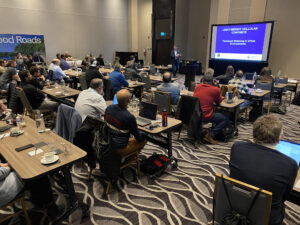
Concrete discussions about industry innovations
By Adam Freill
Concrete Construction Construction Materials Green Construction Leadership RoadsSecond annual Concrete Pavement Seminar was an opportunity to share practical advice about emerging materials and best practices.

Thurber Engineering Ltd.’s Mark Popik discusses lightweight cellular concrete applications during the second annual Concrete Pavement Seminar, presented by Concrete Ontario and the Cement Association of Canada. (Photo by Adam Freill)
More than 60 industry professionals hit Mississauga, Ont., last week for the second annual Concrete Pavement Seminar, presented by Concrete Ontario and the Cement Association of Canada. The day-long event featured several sessions, ranging from updates on key projects and advances in concrete mixes, to technical applications of concrete as a paving medium.
In his discussion about the next generation of pavement, the Cement Association of Canada’s Tim Smith discussed how an examination of project timelines can impact both the strength and the carbon footprint of the concrete being poured. He said, for example, where the project can provide for a longer curing time, it becomes possible to select a concrete mix that will deliver the prescribed strength, while reducing the carbon impact.
“If we start thinking about the carbon footprint of the material, then we can possibly reduce the amount of cementitious material. We can actually go with a later date on the strength, so that we can minimize that cement content and minimize the carbon footprint of the pavement,” he explained. “Something that we need to start thinking about is when is the project going to be open to traffic… if you don’t need that for a while, then maybe we should start thinking, from a global warming potential, of the 56 day or the 92 days strengths instead of 28 days.”
Also leading a technical discussion during the event was Mark Popik of Thurber Engineering Ltd. He shared insights into the use of lightweight cellular concrete applications, outlining a few projects where the material has made it possible to solve some unique problems, such as those that can be created by trying to build a road foundation on soft organic substrates.
Brian Killingsworth of the National Ready Mixed Concrete Association kicked off the afternoon sessions with a look at his organization’s Pave Ahead program.
“We try to partner with other technical groups with representation from contractors, users, cement suppliers, stone suppliers; we all try to work together to be able to promote a product that we fully believe in,” he explained. His organization has created a website containing information that the industry can access without fees, to help with their concrete projects.
“Where we want to help is to be able to step in and say here’s some of the best practices; here’s how you can improve your specifications; here’s some of the tools that you may need, and provide those tools,” he said. “We do that through our design assistance program.”
In addition to outlining some of his organization’s activities, Peter Taylor of the National Concrete Pavement Technology Center talked about water and cement ratios, and provided advice about how admixtures are changing the rules of thumb as the constituents of concrete mixes are changing.
“Do your homework. Do your trial batches,” he advised. “You will get the performance you need, but don’t just flip one [mix] out and put another one in and hope it’s all going to go well.”
After a quick look at some research projects conducted over the past few years at the University of Waterloo’s Centre for Pavement and Transportation Technology, the day wrapped up with a networking social. The dates have been set for next year’s event. The third annual Concrete Pavement Seminar will take place on February 19, 2025. Keep an eye on the Concrete Ontario website for more details.




